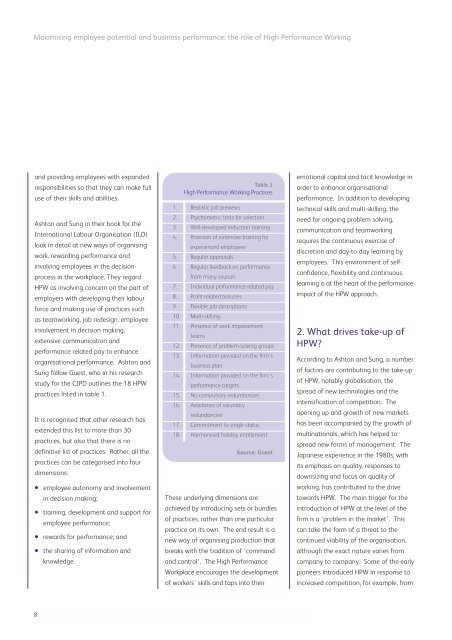About EEF - CIPD
About EEF - CIPD
About EEF - CIPD
You also want an ePaper? Increase the reach of your titles
YUMPU automatically turns print PDFs into web optimized ePapers that Google loves.
Maximising employee potential and business performance: the role of High Performance Workingand providing employees with expandedresponsibilities so that they can make fulluse of their skills and abilities.Ashton and Sung in their book for theInternational Labour Organisation (ILO)look in detail at new ways of organisingwork, rewarding performance andinvolving employees in the decisionprocess in the workplace. They regardHPW as involving concern on the part ofemployers with developing their labourforce and making use of practices suchas teamworking, job redesign, employeeinvolvement in decision making,extensive communication andperformance related pay to enhanceorganisational performance. Ashton andSung follow Guest, who in his researchstudy for the <strong>CIPD</strong> outlines the 18 HPWpractices listed in table 1.It is recognised that other research hasextended this list to more than 30practices, but also that there is nodefinitive list of practices. Rather, all thepractices can be categorised into fourdimensions:• employee autonomy and involvementin decision making;• training, development and support foremployee performance;• rewards for performance; and• the sharing of information andknowledge.Table 1High Performance Working Practices1. Realistic job previews2. Psychometric tests for selection3. Well-developed induction training4. Provision of extensive training forexperienced employees5. Regular appraisals6. Regular feedback on performancefrom many sources7. Individual performance-related pay8. Profit-related bonuses9. Flexible job descriptions10. Multi-skilling11. Presence of work improvementteams12. Presence of problem-solving groups13. Information provided on the firm’sbusiness plan14. Information provided on the firm’sperformance targets15. No compulsory redundancies16. Avoidance of voluntaryredundancies17. Commitment to single status18. Harmonised holiday entitlementSource: GuestThese underlying dimensions areachieved by introducing sets or bundlesof practices, rather than one particularpractice on its own. The end result is anew way of organising production thatbreaks with the tradition of ‘commandand control’. The High PerformanceWorkplace encourages the developmentof workers’ skills and taps into theiremotional capital and tacit knowledge inorder to enhance organisationalperformance. In addition to developingtechnical skills and multi-skilling, theneed for ongoing problem solving,communication and teamworkingrequires the continuous exercise ofdiscretion and day-to-day learning byemployees. This environment of selfconfidence,flexibility and continuouslearning is at the heart of the performanceimpact of the HPW approach.2. What drives take-up ofHPW?According to Ashton and Sung, a numberof factors are contributing to the take-upof HPW, notably globalisation, thespread of new technologies and theintensification of competition. Theopening up and growth of new marketshas been accompanied by the growth ofmultinationals, which has helped tospread new forms of management. TheJapanese experience in the 1980s, withits emphasis on quality, responses todownsizing and focus on quality ofworking, has contributed to the drivetowards HPW. The main trigger for theintroduction of HPW at the level of thefirm is a ‘problem in the market’. Thiscan take the form of a threat to thecontinued viability of the organisation,although the exact nature varies fromcompany to company. Some of the earlypioneers introduced HPW in response toincreased competition, for example, from8
















